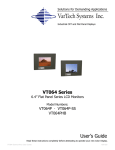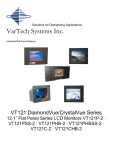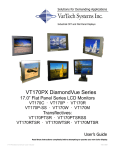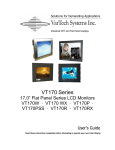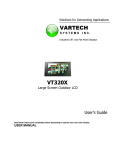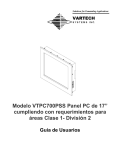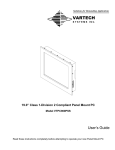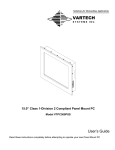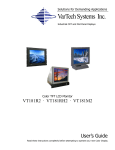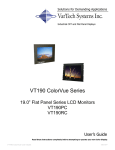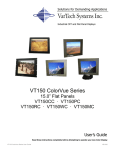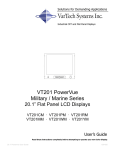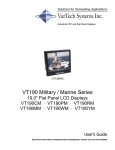Download VarTech Systems VTPC150VDC User`s guide
Transcript
Solutions for Demanding Applications VarTech Systems Inc. Industrial CRT and Flat Panel Displays Chassis Mount Series Flat Panel LCD Monitors VT064C · VT104C · VT121C VT064CHB · VT104CHB User’s Guide Read these instructions completely before attempting to operate your new Color Display. Table Of Contents Section 1 Page Section 4 Introduction Page Touch screen About LCD Monitors 1 Touch Screen Introduction 11 Product Safety Precautions 2 Touch Screen Definition On Safety 2 Touch Screen Serial Interface 12 On Installation 3 Setting up the Touch Interface 12 On Cleaning 3 Installing Windows NT 4.0 Touch Drivers 13 On Repacking 3 Installing Windows 95/98 Touch Drivers 13-14 Installing Windows 2000 Touch Drivers 14 11-12 Section 2 Display Setup Section 5 Display Features 4 Unpacking The Display 4 Included Parts 4 Section 6 Connecting Your Display 5 Cleaning & Maintenance Signal Connections Troubleshooting Tips 15-16 17 5-6 Section 7 Section 3 Mechanical Drawings 18 Getting Started VT064C Mechanical 19 VT104C Mechanical 20 OSD On-Screen Display 7-8 OSD Functions 9-10 Section 8 Specifications 6.4” Specifications 21 10.4” Specifications 22 12.1” Specifications 23 Section 1 INTRODUCTION About LCD Monitors What you gain by using an LCD monitor in your industrial controls LCDs are the future of display technology. CRTs, although they have dropped in cost significantly, do not offer the performance, reliability, and mounting options available with LCDs. LCD monitors consist primarily of an LCD, Video Board and a Back Light video. The LCD determines to a large extent the viewing angle, brightness and contrast. Beyond that it is the function of the video board which converts the analog RGB (Red, Green, Blue) signals from a standard video card to a high quality, digital RGB that the LCD can display. Recently the video card has taken on a new role. It is the responsibility of this device to “scale” a particular video resolution to the “native” resolution of the LCD. Simply, consider that a computer is putting out a VGA [640x480] resolution signal, yet the LCD that is connected is an XGA [1024x768] display. The displayed picture would be in the center 1/3 of the LCD. With the introduction of the scaling engine. The converter will mathematically recalculate the 640x480 to 1024x768. This may sound simple but it is in fact a complex algorithm that adjusts for different aspect ratios and pixel alignment, essentially smoothing text and graphics to produce a picture that is pleasant to the eye. 1 Product Safety Precautions This unit has been engineered and manufactured to ensure your personal safety, however improper use may result in potential electrical shock or fire hazards. In order to allow the proper operation of all safeguards incorporated in this display, observe the following basic rules for its installation, use, and servicing. On Safety Use only the power cord supplied with the unit. In case you use another power cord, make sure that it is certified by the applicable national standards if not being provided by the supplier. If the power cable is faulty in any way, please contact the manufacturer or the nearest authorized repair service provider for a replacement. The power supply cord is used as the main disconnection device. Ensure that them socket-outlet is easily accessible after installation. Operate the display only from a power source indicated in the specifications of this manual or listed on the display. If you are not sure what type of power supply you have, consult with your service or maintenance department. Overloaded AC outlets and extension cords are dangerous. So are frayed power cords and broken plugs. They may result in a shock or fire hazard Call your service technician for replacement. Do not Open the Display. ♦ There are no user serviceable components inside. ♦ There are Dangerous High Voltages inside, even when the power is OFF. ♦ Contact your dealer if the display is not operating properly. To Avoid Personal Injury : ♦ Do not place the display on a sloping shelf unless properly secured. ♦ Use only a stand recommended by the manufacturer. ♦ Do not try to roll a stand with small casters across thresholds or deep pile carpets. To Prevent Fire or Hazards: ♦ Always turn the display OFF if you leave the area for more than a short period of time. ♦ Do not drop or push objects into the display's cabinet openings. Some internal parts carry hazardous voltages. ♦ Do not add accessories that have not been designed for this display. ♦ During a lightning storm or when the display is to be left unattended for an extended period of time, unplug it from the wall outlet. Important Precautions 2 On Installation Do not allow anything to rest upon or roll over the power cord, and do not place the display where the power cord is subject to damage. Do not use this display near water such as near a sink, in a wet location where there is standing water. Displays are provided with ventilation openings in the cabinet to allow the release of heat generated during operation. If these openings are blocked, built-up heat can cause failures which may result in a fire hazard. Therefore, NEVER: ♦ Block any ventilation slots. ♦ Place the display in a built-in enclosure unless proper ventilation is provided. ♦ Cover the openings with cloth or other material. ♦ Place the display near or over a heat source. Do not rub or strike the Active Matrix LCD with anything hard as this may scratch, mar, or damage the Active Matrix LCD permanently. Do not press the LCD screen with your finger for a long time as this may cause some afterimages. Some dot defects may appear as Red, Green or Blue spots on the screen. However, this will have no impact or effect on the display performance. If possible, use the recommended resolution to obtain the best image quality for your LCD display. If used under any mode except the recommended resolution, some scaled or processed images may appear on the screen. However, this is characteristic of the fixed-resolution LCD panel. On Cleaning Unplug the display before cleaning the face of the display screen. Use a 50/50 mix of Isopropyl alcohol and water. Apply with a slightly damp (not wet) lint free cloth. Do not use an aerosol directly on the display screen because over-spraying may cause electrical shock. On Repacking Do not throw away the carton and packing materials. They make an ideal container in which to transport the unit. When shipping the unit to another location, repack it in its original material. 3 Section DISPLAY SETUP 2 Chassis Mount Series Display Features ⇒ Capable of displaying unlimited colors in a continuous spectrum. The high contrast LCD enhances the image with no geometric distortion. ⇒ The Chassis Mount Series is supplied with a Anti-Reflective Screen unless equipped with an optional Touch System. ⇒ The Chassis Mount Series requires 12VDC supply input. Unpacking and setting up your display Your LCD monitor package will consist of the components listed below. Open shipping container and lay all components on a flat clean surface. What is included with your display ⇒ ⇒ ⇒ ⇒ ⇒ ⇒ VT064C, VT104C or VT121C LCD Monitor 5 ft Video Cable (HD15(M) - HD15(M)) 6 ft RS232 Touch Interface Cable (Optional when touch is installed) CD ROM with Touch Screen Drivers (Optional when touch is installed) Power Supply, AC to 12VDC (optional) Users Guide (Printed or on CD) 4 Connecting the Display 1. Connect all cables to the computer first. This would include the VGA cable and the optional RS 232 serial touch screen connection. 2. After connecting the cables between the LCD monitor and the computer, plug the power cord into the 115/220VAC power outlet if using using the optional AC to 12VDC power supply. 3. Once the 115/220VAC connection is made, the display is active. 4. If your computer was off, turn on your computer. 5. Your display should now operate as a normal computer display showing your windows or whatever video is being sent to the flat panel. Note: If for any reason the display goes blank and gives an “out of Range” or “No Sync”, your computer or video source is putting out a signal that is out of range of the LCD’s video board. If this happens, reboot the computer or video source and make sure you are inputting the correct signal. If the display doesn’t work properly, it may be because: The resolution is to high or low for the LCD. (a) The refresh rate is set to high. Refresh on an LCD is different than a CRT. Set the refresh to 60Hz. CRT’s need a high refresh rate to avoid flicker. The refresh rate has no impact on LCD’s. (b) The power source is incorrect. (c) The unit is malfunctioning. If you believe this to be true, disconnect the video cable from the rear of the LCD and connect to a known good computer CRT display. If the computer display is working satisfactory and the video is within the appropriate range, then contact VarTech Customer service for a RMA number. 5 Signal Connections To avoid irregular operation and /or damage to the display, please insure correct video is being supplied as shown on the following page. HD15(F) Connector HD-15 Video Connector Pin Signal Pin Signal Pin Signal 1 Red Video 6 Ground 11 Not Used 2 Green Video 7 Ground 12 DDC Data 3 Blue Video 8 Ground 13 Analog H Sync 4 Not Used 9 Fused VCC 14 Analog V Sync 5 Ground 10 Ground 15 DDC Clock C-Video Connector S-Video Connector C-Video Connector S-Video Connector Pin Signal Pin Signal 1 Ground 1 Ground 2 Ground 2 Composite video signal 3 Luminance 4 Chorminance 6 Section 3 Getting Started 3.1 OSD - On Screen Display The OSD allows selection of input source and fine tuning of various functional parameters like brightness, phase etc. These parameters can be adjusted via push buttons. Visual feedback is provided in the form of an On-Screen-Menu. The OSD Controls are located on the rear of the display. The 4 buttons of OSD control can either be used to navigate within the OSD functions see table 2. For direct call of some special functions see table 1. 7 3.1 OSD - On Screen Display Cont. Table 1 NO. Button name Switch Function 1 Power --- 2 Menu --- 3 Select Auto Adjust 4 Up Reset and Auto Adjust Table 2 NO. Button name Switch Function 1 Power Switch on / off Power 2 Menu 1. First Click: Activate the OSD Main Menu 2. Second Click: Deactivate the OSD Main Menu 3. Leave Sub-Menu / back to Main Menu 3 Select Select the value of OSD Main Menu or value of OSD Sub-Menu and change the value of OSD sub-menu to be able to modify (toggle key) 4 Up 1. Move between Main Menu 2. Move between Sub-Menu inside Main Menu 3. Adjustment of Sub-Menu value inside Main Menu 5 Down 1. Move between Main Menu 2. Move between Sub-Menu inside Main Menu 3. Adjustment of Sub-Menu value inside Main Menu 8 3.2 OSD Functions The Main Menu had 14 different functions. Some of these functions have Sub-Menus OSD Agent Description Brightness Control Adjusts the brightness of video without affecting PC RGB’s brightness. Black Level Adjusts the brightness of the display backlight. Contrast Adjusts the contrast of video without affecting PC RGB’s Contrast. Color Changes the richness of the color. 9 3.2 OSD Functions Cont. The Main Menu had 14 different functions. Some of these functions have Sub-Menus OSD Agent Description Image Position Adjusts the horizontal and vertical position of the display. Image Phase / Clock Removes the noises. When frequency value is wrong, the image has horizontal lines. Auto Configuration Automatically adjusts display for best picture. Information Displays current display mode. Miscellaneous Factory Adjusts the OSD duration and positioning Reset Input Select To select analog, s-video, composite Video Hue Adjusts the Hue and Saturation levels YUV Color Brightness Adjusts the brightness, black level, contrast, saturation, hue, fleshtone. Gamma Moire Adjusts the video gamma and moiré for best display. Save Changes Save OSD changes per adjusted set-up. 10 Section Touch Screen 4 4.1 Touch Screen Introduction Touch screen interfaces have become the standard interface in the past 5 years. They are, rugged, reliable, extremely flexible and easier than ever to implement! Over 90% of the display packages Vartech Systems builds are touch screen systems. If you are uncertain about using a touch screen, or are having difficulty, please call us. The universal acceptance of the Windows GUI [Graphical User Interface] along with the extensive use of a mouse interface has significantly accelerated the use of touch interface. Basically think of your touch screen as if it were a mouse. 4.2 Touch Screen Definition Quite simply, Vartech Systems touch systems are a mouse emulator. By installing a software driver and connecting to a serial port, the touch screen will support all the primary mouse functions: Our standard touch screen interface, is a high resolution analog resistive. Following is a quick explanation of what all this means. High Resolution: The touch screen resolution is 400 ppi [points per inch] Analog Resistive: The actual touch glass is an analog device. Meaning there is a very low voltage applied to the X and Y axis of the touch screen. This current is applied to ITO [Iridium Tin Oxide] that is sputtered onto a polyester membrane. When you touch the screen you are changing the resistance on both the X and Y axis, producing an analog value that references a particular location. This type of screen can be activated with a gloved finger or mechanical stylus. The touch screen itself is connected to electronics that provide the Analog to Digital conversion. When the screen is touched, the electronics convert the analog voltage to a digital value and add a “Mouse Click”, then sends the data to the serial port that the driver is loaded to. When the touch is released the new XY location is sent along with a “Mouse Up Click”. This system requires no special software knowledge, and can be installed and set up in minutes. The following section gives a detailed explanation of the software setup and configuration. Since the touch screen interface is RS-232, the recommend maximum distance from the PC is 50 feet. In reality, every application is different. The touch driver default baud rate is 9600, and we have tested the driver and interface with good quality cables to 50 feet. With RS-232 line drivers this can be extended almost indefinitely. 11 4.2 Touch Screen Definition Cont. Connecting the touch screen 1. Make sure all optional cables have been received. 2. Connect one end of the 6 foot touch screen serial cable to the touch screen port D9 connector on the side of the monitor. 3. Connect the other end to any communications port on the host computer. 4. Tighten the captive screws on the cable connector to secure it. 4.3 Touch Screen Serial Interface All touch controllers are configured by default to provide serial communications at 9600 baud, 8 data bits, 1 stop bit, no parity. For Vartech flat panels equipped with touch screens, a serial communications cable is required. This 6 foot cable comes with the unit in the accessory kit. The cable is a straight wired serial (RS-232) cable with a male DE-9 D-shell connector on the monitor end. The cable provides a communications channel between the touch screen controller, which is mounted inside the monitor, and an RS-232 serial port on the host computer. Because the touch controller obtains power from the monitor's power supply, no external touch power connections are necessary. Software supplied with the touch screen must be loaded on the host computer to handle communications with the touch controller over the channel. Because the touch screen emulates a mouse, there may be compatibility issues involving how the touch screen emulates mouse buttons, especially multiple buttons. 4.4 Setting up the Touch Screen Interface Enabling the Touch Screen Interface The Flat Panel Monitor provides a female DE-9 connector for the touch interface. This connector provides the serial interface for the touch controller. Interconnecting wiring to the host serial port connection is shown in the following table. Touch screen Interface Monitor (DCE Device) DE-9 (Female) 1 2 3 4 5 6 7 8 9 Signal Description Not Connected (DCD) Transmit Data (TXD) Receive Data (RXD) Data Terminal Ready (DTR) Common Signal Return (SG) Not Connected (DSR) Request To Send (RTS) Clear To Send (CTS) Not Connected 12 Host (DTE Device) DE-9 (Male) DB-25 (Male) 1 8 2 3 3 2 4 20 5 7 6 6 7 4 8 5 9 22 4.5 Installing Touch Screen Driver Windows NT 4.0 1. Start your computer. 2. Insert the MonitorMouse for Windows NT disk into drive A. 3. Click the Start button then click Run. 4. Type “a:\setup” in the space provided and press Enter. 5. Follow the directions on the screen. 6. MonitorMouse for Windows NT provides two Installation options. Most users should select Typical (the default) and click Next to continue. Custom allows you to install the sample touch screen programming files. 7. The Touch screen Setup dialog box will appear. Specify the type of touch screen controller you are using and how it is connected. Also specify the language you want to use in the Touch screen Control Panel. Click OK to confirm that the Setup is correct. 8. Complete the Setup program. 9. Shutdown and restart Windows NT. Continue the steps on the next page. 10. Click the Start button, then click Settings, then click Control Panel. 11. Double-click Elo Touch screen to run the Touch screen Control Panel. 12. Click the Calibrate button and touch each of the three targets as they appear on the screen. Touch Yes when the cursor lines up correctly with your finger. Touch OK to close the Touch screen Control Panel. Note: If at any time the screen cursor is not directly under your finger on a touch, the touch screen can be re calibrated at anytime by going to the Windows control panel and selecting the Elo Icon and selecting Calibrate. 4.6 Installing Touch Screen Driver Windows 95/98 Start your computer. 2. Insert the MonitorMouse for Windows 95 disk into drive A. 3. Click the Start button then click Run. 4. Type “a:\setup” in the space provided and press Enter. 5. Follow the directions on the screen. 6. MonitorMouse for Windows 95 provides two installation options. Most users should select Typical: (the default) and click Next to continue. Custom: allows you to install the sample touch screen programming files. 7. The Touch screen Setup dialog box will appear. Specify the type of touch screen controller you are using (Serial SmartSet Model 2210) and how it is connected. Click OK to confirm that the Setup is correct. 8. Complete the Setup program. 9. Restart Windows 95/98. 10. Click the Start button, then click Settings, then click Control Panel. 13 4.6 Installing Touch Screen Driver Windows 95/98 Cont. 11. Double-click Elo Touch screen to run the touch screen control panel. 12. Click the Calibrate button and touch each of the three targets as they appear on the screen. 13. Click yes when the cursor lines up correctly with your finger. Click OK to close the touch screen control panel. Note: If at any time the screen cursor is not directly under your finger on a touch, the touch screen can be calibrated at anytime by going to the Windows control panel and selecting the Elo Icon and select Calibrate. 4.7 Installing Touch Screen Driver Windows 2000 1. Start your computer. 2. Insert the MonitorMouse for Windows 2000 disk into drive A. 3. Click the Start button then click Run. 4. Type “a:\setup” in the space provided and press Enter. 5. Follow the directions on the screen. 6. MonitorMouse for Windows 2000 provides two Installation options. Most users should select Typical (the default) and click Next to continue. Custom allows you to install the sample touch screen programming files. 7. The Touch screen Setup dialog box will appear. Specify the type of touch screen controller you are using and how it is connected. Also specify the language you want to use in the Touch screen Control Panel. Click OK to confirm that the Setup is correct. 8. Complete the Setup program. 9. Shutdown and restart Windows 2000. Continue the steps on the next page. 10. Click the Start button, then click Settings, then click Control Panel. 11. Double-click Elo Touch screen to run the Touch screen Control Panel. 12. Click the Calibrate button and touch each of the three targets as they appear on the screen. Touch Yes when the cursor lines up correctly with your finger. Touch OK to close the Touch screen Control Panel. Note: If at any time the screen cursor is not directly under your finger on a touch, the touch screen can be re-calibrated at anytime by going to the Windows control panel and selecting the Elo Icon and selecting Calibrate. Note: For latest touch information, refer to www.elotouch.com 14 Section 5 No Picture Troubleshooting Tips • • • • • The signal cable should be properly connected to the display card and computer. Try disconnecting the video cable from the display and connecting to a CRT display if available to confirm the presence of proper video. Make sure power is connected to the proper DC or AC source. Make sure the resolution mode is supported by the display and check settings of the display card. Confirm that the video cable is not defective. Image Persistence Image persistence occurs when a ghost of an image remains on the screen after the monitor has been turned off. Unlike a CRT monitor, an LCD monitor’s image persistence is not permanent. To erase an image ghost, turn the monitor off for as long as the image was displayed. If the image was on for one hour and the ghost of the image remains, the display should be turned off for one hour to erase the image. To avoid this problem, use a screen saver. Picture Quality & Image Stability • • • • Check for proper video cable for proper grounding and shielding. Check the signal source for proper signal. Check for proper adjustment of the Phase and Frequency controls. Check for proper recommended signal timing. Display image is not properly sized • • Adjust the Vertical and Horizontal size controls via the OSD. (Reference setup adjustments) Ensure that a supported mode is selected on the display card or system being used. Consult the display card or system manual for proper video. No S-Video or NTSC operation • • Check for proper connections. Check the setup instructions for proper input selection. Screen is blank. • • • • Screen saver activated. Video Cable problem. Check for proper installation Change video cable Faulty video display. Needs Service 15 5.0 Troubleshooting Tips Cont. Image is dim, even with brightness • and contrast controls set full UP. • • • Video cable problem. Check for proper installation of cables Faulty video source Faulty display Image not centered Reset the horizontal and vertical positioning using the on-screen menu. Check to see if video source is operating within the monitor’s range. Image will not adjust Video timing outside of range. Use the on-screen menu to ad just the Clock Setting. Make sure timing is within VESA standard. Image is not stable. Monitor has incorrect or bad sync signals. Check for proper video cable installation. Replace suspected faulty cable. Check to ensure that video source is operating within the display’s range. Vertical shaded bars on screen im- Horizontal size not properly adjusted. Adjust horizontal size settings. age Colors are missing • • Faulty video cable. Missing from video source. Connect video source to another display. Screen jitter or noisy display • • • Monitor clock phase not properly adjusted. Video cable problem External noise interference. Slight distortion in text or Graphics. Not working in native resolution. Display is present but “bars” appear or roll across screen Ground loop problem between computer and display Interference from adjacent equipment. The background looks acceptable but text and icons seem to be missing rows of pixels Video running interlace mode. If these tips do not solve your problem, contact VarTech Systems Customer Service support. 16 Section Cleaning and Maintenance 6 Cleaning Occasionally clean the display panel and cabinet with a soft cloth dampened (not soaked) with a mild (non-abrasive) glass cleaner. Keep turning a fresh side of the cloth toward the screen surface to avoid scratching it with accumulated grit. Do not use paper products as they may scratch the surface. To minimize the risk of abrasion, allow the screen to stand dry. Note: The solvent (a 50/50 mixture isopropyl alcohol and water) should be applied only to the cloth, and not directly on the monitor screen. Special care should be taken when cleaning a touch screen or polycarbonate shield that is installed over the screen. Abrasive and certain chemical cleaners can easily damage the surface. Never use alcoholic or ammoniac cleaners to clean the polycarbonate shield or a touch screen. Replacing a Line Cord To avoid shock and fire hazards, the monitor’s power cord should be replaced if the insulation becomes broken or if it develops a loose internal connection. Other Maintenance Qualified service personnel should perform all maintenance, except for the power cord replacement described above. 17 Section 7 MOUNTING INSTRUCTIONS Mechanical Drawings Model Description Page(s) VT064C 6.4” Chassis Mount Mechanical Drawing 19 VT104C 10.4” Chassis Mount Mechanical Drawing 20 18 Section Specifications 8 6.4” Specifications Panel Size Type Max. Resolution Active Diagonal Active Display Area Pixel Format Viewing Angle (Up/Down) Viewing Angle (Left/Right) Contrast Ratio Brightness Response Time Back Lights Video Connectors Video Input Sync Colors Supported Power Input Power consumption Operating Temperature Storage Temperature Operating Humidity Storage Humidity Operating Altitude Storage Altitude 6.4” TFT Active matrix VGA 6.4” Viewable 5.10” (w) x 3.84” (h) 129.6mm x 97.44mm 640 x 480 110º 70º 180:1 VT064C: 300 Nits VT064CHB: 700 Nits TR = 30ms TD = 50ms 20,000 Hours CCFL 25,000 MTBF HD15(F) RCA (NTSC) 5 Pin Mini Din (S-Video) RGB Analog (0.7V p-p / 75ohm) CVBS (1.0V p-p) S-VHS, luma/chroma (.7V p-p / 75ohm) NTSC Separate H&V Combined, SOG (Sync On Green) 262,000 12VDC @ 1.5A Normal: 35 Watts @ +12V 4 Watts Sleep Mode 0 to 50ºC -20 to 60ºC 10 to 95% NC 10 to 95% NC Up to 10,000 ft Up to 40,000 ft 21 10.4” Specifications Panel Size Type Max. Resolution Active Diagonal Active Display Area Pixel Format Viewing Angle (Up/Down) Viewing Angle (Left/Right) Contrast Ratio Brightness Response Time Back Lights Video Connectors Video Input Sync Colors Supported Power Input Power consumption Operating Temperature Storage Temperature Operating Humidity Storage Humidity Operating Altitude Storage Altitude 10.4” TFT Active matrix VGA 10.4” Viewable 8.32” (w) x 6.24” (h) 211.2mm x 158.4mm 640 x 480 110º 70º 300:1 VT104C: 380 Nits VT104CHB: 850 Nits TR = 15ms TD = 35ms 40,000 Hours CCFL 25,000 MTBF HD15(F) RCA (NTSC) 5 Pin Mini Din (S-Video) RGB Analog (0.7V p-p / 75ohm) CVBS (1.0V p-p) S-VHS, luma/chroma (.7V p-p / 75ohm) NTSC Separate H&V Combined, SOG (Sync On Green) 262,000 12VDC @ 1.5A Normal: 35 Watts @ +12V 4 Watts Sleep Mode 0 to 50ºC -20 to 60ºC 10 to 95% NC 10 to 95% NC Up to 10,000 ft Up to 40,000 ft 23 12.1” Specifications Panel Size Type Max. Resolution Active Diagonal Active Display Area Pixel Format Viewing Angle (Up/Down) Viewing Angle (Left/Right) Contrast Ratio Brightness Response Time Back Lights Video Connectors Video Input Sync Colors Supported Power Input Power consumption Operating Temperature Storage Temperature Operating Humidity Storage Humidity Operating Altitude Storage Altitude 12.1” TFT Active matrix VGA 12.1” Viewable 9.69” (w) x 7.26” (h) 246mm x 184.5mm 640 x 480, 800 x 600 120º 90º 300:1 VT121C: 300 Nits TR = 20ms TD = 30ms 50,000 Hours CCFL 25,000 MTBF HD15(F) RCA (NTSC) 5 Pin Mini Din (S-Video) RGB Analog (0.7V p-p / 75ohm) CVBS (1.0V p-p) S-VHS, luma/chroma (.7V p-p / 75ohm) NTSC Separate H&V Combined, SOG (Sync On Green) 262,000 12VDC @ 1.6A Normal: 35 Watts @ +12V 4 Watts Sleep Mode 0 to 50ºC -20 to 60ºC 10 to 95% NC 10 to 95% NC Up to 10,000 ft Up to 40,000 ft 22 VARTECH SYSTEMS HEADQUARTERS 11529 Sun Belt Ct. Baton Rouge, Louisiana 70809 Toll-Free: 800.223.8050 International Phone: 001.225.298.0300 Fax: 225.297.2440 E-mail: [email protected] www.vartechsystems.com 150-037-005 3.18.04
























